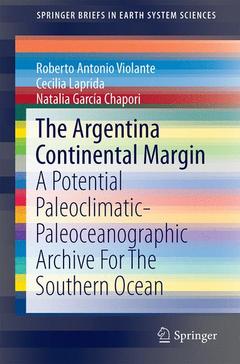The Argentina Continental Margin, 1st ed. 2017 A Potential Paleoclimatic-Paleoceanographic Archive for the Southern Ocean SpringerBriefs in Earth System Sciences Series
Auteurs : Violante Roberto A., Laprida Cecilia, García Chapori Natalia L.

As a result of this complexity in the regional processes in the framework of the broad hemispheric oceanographic-climatic conditioning factors, the ACM can be considered as a complete archive for the Southern Ocean.
The Argentina Continental Margin (ACM).- Location in the context of the Southern Hemisphere, the southern tip of South America and Antarctica.- The ACM as an archive for paleoclimatic and paleoceanographic changes.- Local and regional processes: climate, oceanography, sea-level fluctuations, isostasy, tectonism, sediment supply, sedimentary processes.- Oceanographic Context: interaction between Antarctic and Equator water-masses.- Environments: continental shelf, slope, rise, ocean basin.- Sedimentary processes in each of them: along-shore and across-shore processes.- Effects of the sea-level fluctuations on the shelf.- Effects of the water-masses circulation on the slope and rise.- Turbiditic and contouritic processes.- Morphosedimentary features in each environment.- The significance of the ACM as a potential archive for understanding local and regional processes.
He has been working at the Argentina Hydrographic Survey since 1975, in the division of Marine Geology and Geophysics (Department of Oceanography). He is presently a Principal Researcher, Projects Director and Chief of the Marine Geology Section. His main research interests are: marine, coastal and lacustrine geology; sedimentary process; seismic-stratigraphy; geomorphology; marine sedimentation (shelf-slope); contouritic and turbiditic processes.
Includes supplementary material: sn.pub/extras
Date de parution : 03-2017
Ouvrage de 117 p.
15.5x23.5 cm
Disponible chez l'éditeur (délai d'approvisionnement : 15 jours).
Prix indicatif 52,74 €
Ajouter au panier